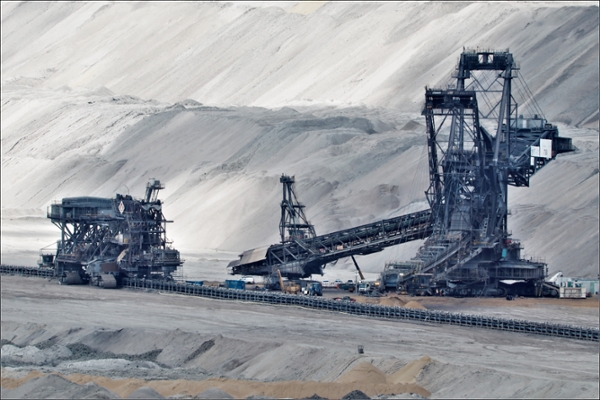
Canada’s Critical Mineral Strategy: Opportunities and Challenges for the Development of Critical Mineral Supply Chain in Saskatchewan
Saskatchewan has a significant endowment of critical minerals and Rare Earth Elements. With the right policies the province can become a major player in the supply chain for development of low-carbon, clean, and renewable energy technologies needed to address climate change.
By Albert I. Ugochukwu, Senior Policy Fellow, Centre for the Study of Science and Innovation Policy, Johnson Shoyama Graduate School of Public Policy (JSGS)Download the JSGS Policy Brief
Download the Discussion Questions
Western Canada makes up approximately 40% of Canada's GDP. It has abundant natural resources such as oil, potash, and uranium. Moreover, the province has significant critical minerals like lithium, graphite, nickel, cobalt, copper, and rare earth elements, including praseodymium and neodymium used in electric vehicle motors. In an era when addressing climate change is a key public policy issue, critical and rare earth minerals represent a major economic opportunity.
Globally, the use of essential minerals and rare earth elements (REEs) in low-carbon, clean, and renewable energy technologies is rapidly rising in importance. Just how important became evident when all 198 nations at the recent COP 28 summit signalled the need to transition away from fossil fuel energy as part of global efforts to address climate change. Electric car batteries, solar panels, mobile phones, medical and healthcare applications, wind turbines, and permanent magnets are just a few of the products currently in high demand and that use critical minerals (like lithium, graphite, cobalt, nickel, and copper) and REEs (like neodymium, praseodymium).
To fully capitalize on the prospects in the developing mineral markets where demand has been predicted to overwhelm supply, investments have been made to establish essential minerals supply chains. With many nations, including Canada, setting net-zero emission target dates, there has been a surge in demand in recent years for electric vehicles and energy storage (such as solar panels). There is every reason to believe that demand for critical minerals will only keep escalating.
Background
Currently, the electric vehicle market is predominantly controlled by three nations: China, Europe, and the United States. In 2023, the International Energy Agency (IEA, 2023) reported global sales exceeding 10 million electric vehicles, with China leading the way at approximately 60 percent of total sales. Notably, according to IEA data, during the same period Europe experienced a sales growth of over 15 percent, and the United States saw a significant 55 percent increase in electric vehicle sales. Due to the decreasing costs of solar modules, Bloomberg Intelligence’s Global Solar Energy Mid-year Outlook anticipates a potential 30 – 40 percent increase in global demand in 2023. According to the Solar Power Management journal, this surge in demand is projected to contribute to a substantial 35 percent growth in industry revenue.
Canada experienced a notable 25.9 percent growth in solar energy in 2022, and the western region of the country played a significant role, contributing to 98 percent of the overall expansion, as reported by the Canadian Renewable Energy Association in 2022. Furthermore, due to the rising use of rechargeable lithium-ion batteries for various uses, the demand for lithium and graphite has increased dramatically (Baines and Pede, 2021). According to predictions made by the IEA (IEA, 2022) by 2030, electric vehicles will account for half of all light vehicle sales worldwide.
Additionally, according to projections made by the IEA, the global capacity of renewable energy will double by 2030, reaching $400 billion by 2040. The IEA forecasts that global annual renewable energy investment would need to more than triple to $4 trillion by 2030 in order to achieve net zero emissions by 2050 (IEA 2021).
The Zero-Emission Vehicles (ZEV) sector in North America is expected to generate more than 220,000 more jobs in manufacturing, processing, and mining by 2030, according to the IEA. Research by JP Morgan (Galler, 2023) indicates market deficits for lithium and copper are predicted to reach 700kt and 4.7mt, respectively, by 2030 based on the current supply of critical minerals and REEs, while production of lithium, graphite, and cobalt is predicted to increase by 500% by 2050 to meet global demand (World Bank, 2020). To meet this demand shortfall, major capital investment is needed for the development of essential minerals and REEs. However, this substantial increase in demand, driven by the shift away from fossil fuel energy, will necessitate an equally substantial investment in the electric grid infrastructure, which will have to at least double by 2050, a challenge the Public Policy Forum in Ottawa calls the “Project of the Century.” The Conference Board of Canada has put the investment cost to build the net zero electrical grid we need at $1.7 trillion, roughly equal to Canada’s total economy today.
Looking at supply (export) and demand (import) markets for critical minerals and REEs, the top 10 global suppliers include China, the United States, Myanmar, Australia, Thailand, Madagascar, India, Russia, Brazil, and Vietnam; while the largest consuming countries/regions include China, Japan, United States, South Korea, and Europe.
Table 1: 2021 vs 2020 domestic production of REEs (000’ MT)
| Country | China | US | Myanmar | Australia | Thailand | Madagascar | India | Russia | Brazil | Vietnam |
| 2021 | 168 | 43 | 26 | 22 | 8 | 3.2 | 2.9 | 2.7 | 0.5 | 0.4 |
| 2020 | 140 | 39 | 31 | 21 | 3.6 | 2.8 | 2.9 | 2.7 | n/a | 0.7 |
Source: Investing News Network (2022)
China accounts for about 95 percent of the global production of REEs and supplies 97 percent of the world’s demand. The military coup in Myanmar affected production in 2021. The upheaval, which led to the death and arrest of hundreds of people protesting the coup, caused disruptions in the production of rare elements and transportation of materials to the border for trade. This situation significantly impacted China, which depends on Myanmar for approximately 50 percent of its rare earth concentrates.
As a consequence, Canada holds the potential to emerge as a major global supplier of numerous essential minerals and REEs, presenting a significant opportunity to enhance the supply to both local and international markets. Given the need to develop Canada's critical mineral supply or value chain, six minerals, including lithium, graphite, nickel, cobalt, copper, and rare earth elements (REEs), have been given early priority. The reason is their great potential for economic growth and employment opportunities across the entire value chain, as well as their use and support in the manufacture of value-added products (e.g., clean technologies, advanced manufacturing, information and communication technologies).
Why is Saskatchewan important in achieving Canada’s strategy?
In Canada's Critical Mineral Strategy, Saskatchewan has a competitive advantage. The province is endowed with 23 of the 31 critical minerals and REEs on Canada’s list, including the six prioritized by Canada for clean energy transition and whose world supply is under threat in the next years due to increased demand.
Based on data from the World Nuclear Association in August 2023, Saskatchewan ranked as the world’s second-largest producer of high-grade uranium in 2022, following Kazakhstan, with total sales amounting to approximately $1 billion. Moreover, as the world's second-largest uranium producer, Saskatchewan’s uranium deposits have been discovered to include REEs with great commercial potential, placing the province as a hub for REEs production and processing relative to Ontario and Quebec with large mining sectors.
Add to that fact Saskatchewan is already recognized as the primary producer of helium in Canada, boasting the largest purification facility, with the province now emerging as a leading lithium producer. This shift is attributed to the innovative brine extraction processes introduced by Prairie Lithium Corporation, enabling the extraction of lithium within a matter of minutes. The province has extensive mining expertise and capabilities, as well as proactive environmental, social, and governance (ESG) disclosure, regulations, and risk management, to ensure best practices, ethical conduct, and mitigation of environmental impacts on land, soil, and greenhouse gas emissions (SMA, 2021).
Strategic opportunities and challenges for Saskatchewan
Endowed with the six early prioritized important minerals and REEs (neodymium and praseodymium) by the Government of Canada, Saskatchewan is positioned to secure its position as a supplier of key minerals, generating greater foreign exchange profits and economic growth. Having said that, the development of essential mineral supply networks in Saskatchewan will bring both possibilities and problems. Among the possibilities are
- Support economic growth and competitiveness by creating jobs, adding value (processing), and gaining market access (trade). Currently, Saskatchewan's mineral exploration and mining sector contributes $7 billion to the provincial GDP each year and is the greatest employer of indigenous people as well as a consumer of indigenous-owned supply chain businesses. The development of essential minerals will necessitate the creation of more jobs at each stage of the value chain as well as the growth of small companies within communities. Domestic processing (value addition) and innovative manufacturing will strengthen alliances, attract foreign direct investment, and provide access to new markets.
- Promote worker diversity and inclusivity, as well as indigenous reconciliation. The development of essential minerals exploration, processing, mining, manufacturing, and recycling subsectors in various communities necessitates the protection of indigenous people's treaty rights. It will also increase workforce diversity for a variety of organizations, including women and youth from indigenous communities, black Canadians, and immigrants. The Prairies Economic Development Canada (PrairiesCan), whose strategic priorities include promoting inclusivity by facilitating the economic involvement of marginalized populations like Indigenous Peoples and helping to achieve a green economy and a net zero future, can play a pivotal role in realizing this opportunity. PrairieCAN can act as an 'advisor' by involving indigenous governments (at various levels) and organizations in the conception, planning, development, and oversight of mineral projects; as a 'convenor' by facilitating partnerships between government, indigenous peoples, and industry to foster collaboration; and as a 'pathfinder' by ensuring that indigenous women and youth have employment opportunities within the sector.
Potential challenges include:
- Environmental impact. According to research, rare earth metal sources naturally contain radioactive elements (such as thorium) that can contaminate streams, lakes, and tailings. The current regulatory frameworks and knowledge in uranium mining and tailings management in Saskatchewan, on the other hand, might be applied to the extraction of REEs and other essential minerals.
- Mining corporations acquiring a social license to operate, access to cash, and water management. By involving local and Indigenous (First Nations) stakeholders, PrairiesCan can help secure social licenses. Communities should be made partners in the projects and profit from them. Critical mineral mining is water intensive, and Saskatchewan has water issues as a result of climate change and other economic activity.
Recommendations
The following recommendations are based on the preceding analysis:
- Due to the high cost of exploration, it is necessary to identify and access several innovative sources of money to fund mining operations. Tax breaks could be used to incentivize private-sector investment. In addition to the non-refundable 30 percent tax credit offered to private investors by mining/exploration companies in Saskatchewan, export tax rebates could help spur development. In China an export tax credit helped establish a significant presence in the global market and contributed to a notable increase in its share of the global mining output, rising from 21.4 percent to 60.1 percent. Similar incentives could be considered a positive step by the Government of Canada and Saskatchewan to attract investments in the mineral sector.
- To promote private sector investment in energy assets, the national and provincial regulatory environments must be streamlined and strengthened. A public-private collaboration with clear political and regulatory support will assist in developing the necessary technical capacity, reducing uncertainty, and improving development outcomes.
- Creating incentives for new technologies (e.g., rebates on electric car purchases) will increase acceptance and use to reduce GHG emissions.
- Encourage domestic production of clean and renewable energy (e.g., solar panels) components by using locally available minerals will help assure domestic mining sector and clean technology sustainability.
- Disagreements between stakeholders, namely industry, government and Indigenous People have presented obstacles to investments in Canada’s natural resources. Strengthening the ongoing Indigenous reconciliation efforts at the federal, regional, and provincial levels is crucial. Involving Indigenous People in the various aspects of mining, whether in terms of operations or equity partnerships, can enhance the safety and sustainability of mining activities within their jurisdictions.
Conclusion
As the world transitions to a low-carbon energy future, Saskatchewan is well positioned to create value amid rising demand for its endowed critical minerals and contribute to the provision of global energy needs through responsible critical mineral value chain development and local production, processing, and recycling.
Albert I. Ugochukwu

Albert I. Ugochukwu is a Senior Policy Fellow at the Centre for the Study of Science and Innovation Policy in the Johnson Shoyama Graduate School of Public Policy (JSGS) at the University of Saskatchewan. His research focuses on food security and safety, trade, innovation, value chain development, sustainable international development, environment and biodiversity conservation, technology adoption and commercialization, markets, and rural development. Ugochukwu has participated in research projects funded by governments, specialized, and international donor agencies, and has consulted for several international development agencies including USAID, World Bank, United Nations, DFID, Agriculture and Agri-Food Canada, and African Development Bank. He holds a PhD from the University of Saskatchewan and has authored/co-authored several journal articles and a book chapter.
Endnotes
Baines, S.C. and Pede, M. (2021). Opportunity Knocks: Lithium and Graphite Development in Canada. September 28, 2021. Available at: https://www.osler.com/en/blogs/energy/september-2021/opportunity-knocks-lithium-and-graphite-development-in-canada
Canadian Renewable Energy Association (2022). Canada’s Wind, Solar and Energy Storage Sector grew by 10.5% in 2022.
IEA (2021). Net Zero by 2050: A Roadmap for the Global Energy Sector. IEA, Paris. https://www.iea.org/reports/net-zero-by-2050, License: CC BY 4.0
IEA (2022). By 2030 EVs represent more than 60% of vehicles sold globally, and require an adequate surge in chargers installed in buildings, IEA, Paris https://www.iea.org/reports/by-2030-evs-represent-more-than-60-of-vehicles-sold-globally-and-require-an-adequate-surge-in-chargers-installed-in-buildings, License: CC BY 4.0
IEA (2023). Global EV Outlook 2023, IEA, Paris https://www.iea.org/reports/global-ev-outlook-2023, License: CC BY 4.0
Galler, T. (2023). A New Supercycle – The Clean Tech Transition and Implications for Global Commodities.
Investing News Network (2022). Top Ten Countries for Rare Element Metal Production.
Public Policy Forum, Project of the Century, www.ppforum.ca/publications/net-zero-electricity-canada-capacity
Saskatchewan Mining Association (2021). BEYOND Environmental, Social and Governance Disclosure in Mining. Available at: http://saskmining.ca/ckfinder/userfiles/files/ESG%20article.pdf.
Solar Power Management, https://solarpowermanagement.net/article/117056/Solar_energy_demand_could_rise_by_40_in_2023
Sommerfeld, L. (2012). An Overview of Water & Economic Growth in Western Canada. Stress Points, March 2012. Canada West Foundation Arthur J.E. Child Foundation Water Project. Available at: https://cwf.ca/wp-content/uploads/2015/11/CWF_StressPoints_Report_MAR2012.pdf
World Bank (2020). Climate-Smart Mining: Minerals for Climate Action. World Bank Brief, 2020. Available at: https://www.worldbank.org/en/topic/extractiveindustries/brief/climate-smart-mining-minerals-for-climate-action.
World Nuclear Association (2023). Uranium Production Figures, 2013 – 2022. Available at: https://world-nuclear.org/information-library/facts-and-figures/uranium-production-figures.aspx. Accessed on December 12, 2023.


